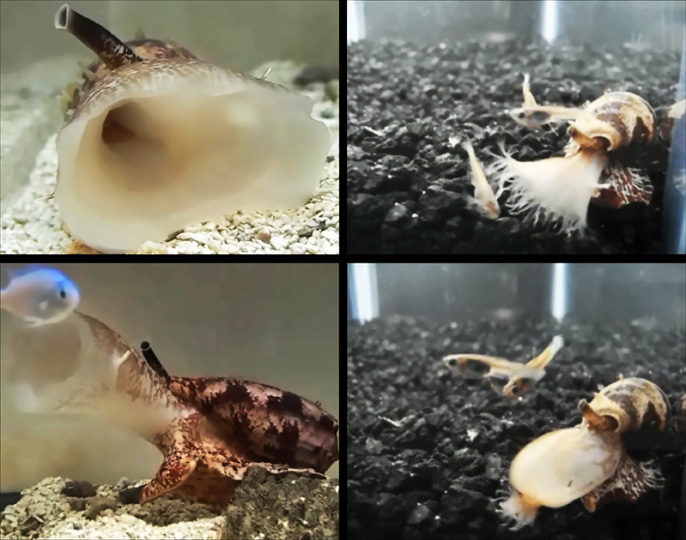Predatory Sea Snails Produce Weaponized Insulin

Jason Biggs and Baldomero Olivera The images show two species of cone snail, Conus geographus (left) and Conus tulipa (right) attempting to capture their fish prey. As they approach potential prey, the snails release a specialized insulin into the water, along with neurotoxins that inhibit sensory circuits, resulting in hypoglycemic, sensory-deprived fish that are easier to engulf with their large, distensible false mouths. Once engulfed, powerful paralytic toxins are injected by the snail into each fish.
As predators go, cone snails are slow-moving and lack the typical fighting parts. They’ve made up for it by producing a vast array of fast-acting toxins that target the nervous systems of prey. A new study reveals that some cone snails add a weaponized form of insulin to the venom cocktail they use to disable fish.
“It is very unlikely that it is serving a different purpose,” said lead author Helena Safavi-Hemami, a research assistant professor at the University of Utah.
“This is a unique type of insulin. It is shorter than any insulin that has been described in any animal,” said senior author Baldomero M. Olivera, a distinguished professor of biology at the University of Utah. “We found it in the venom in large amounts.”
A synthetic form of the snail insulin, when injected into zebrafish, caused blood glucose levels to plummet. The insulin also disrupted swimming behavior in fish exposed through water contact, as measured by the percentage of time spent swimming and frequency of movements. The researchers propose that adding insulin to the mix of venom toxins enabled predatory cone snails to disable entire schools of swimming fish with hypoglycemic shock. The study appears in Proceedings of the National Academy of Sciences.
Cone snails are abundant in most tropical marine waters, especially around coral reefs. Each species makes a distinct repertoire of venom compounds, mixtures that have evolved to target particular prey. Conus geographus, a cone snail that has killed dozens of people in accidental encounters, traps fish by releasing a blend of immobilizing venoms into the water, according to the prevailing hypothesis. The snail protrudes a stretchy mouth-like part and aims it like a gun barrel at fish, which become disoriented and stop moving even as the snail’s mouth part slowly advances and engulfs the fish.
Seeking to understand how the cone snail springs its slow-motion trap, the Utah researchers searched the gene sequences of all of the proteins expressed in the venom gland of Conus geographus. They found two sequences that looked surprisingly similar to that of the hormone insulin, used by humans and other vertebrate animals to regulate energy metabolism. The insulin genes were more highly expressed in the venom gland than genes for some of the established venom toxins. One sequence proved very similar to that of fish insulin. Chemical analysis of venom confirmed that it contained abundant amounts of this insulin.
The type of insulin found in venom glands seems to match the prey of a given cone snail. Fish insulin was present in the venoms of Conus geographus and Conus tulipa, which both practice the same fish-trapping method. But the Utah researchers found no evidence of fish insulin in the venom of five species of fish-eating cone snails that are ambush hunters that attack with a harpoon-like organ. Nor did they find fish insulin in the venom of cone snails that prey on molluscs or worms. (Those snails expressed insulins similar to those used by mollusc and worms.)
For more clear-cut evidence that snails use insulin as a weapon, Joanna Gajewiak, a research assistant professor at the university, came up with a fast way to synthesize enough of the insulin to directly test its effects on fish. The team was concerned about getting scooped by competitors. “We knew that other people could stumble upon this very soon,” Safavi-Hemami said.
The snail insulin could prove useful as a tool to probe the systems the human body uses to control blood sugar and energy metabolism. The snail insulin consists of 43 amino acid building blocks, fewer than any known insulin. Its stripped down size and odd chemical modifications may have evolved as a way to make it better at causing hypoglycemia in prey.
###
University of Utah Communications
75 Fort Douglas Boulevard, Salt Lake City, UT 84113
801-581-6773 fax: 801-585-3350
www.unews.utah.edu
Contact Information
— Helena Safavi-Hemami, research assistant professor, University of Utah – office 801-581-8370, cell 801-428-9511, safavihelena@gmail.com
— Baldomero Olivera, distinguished professor, University of Utah – office 801-581-8370, olivera@biology.utah.edu
— Joe Rojas-Burke, senior science writer, University of Utah Communications Office – office 801-585-6861, cell 503-896-1079, joe.rojas@utah.edu
Media Contact
All latest news from the category: Life Sciences and Chemistry
Articles and reports from the Life Sciences and chemistry area deal with applied and basic research into modern biology, chemistry and human medicine.
Valuable information can be found on a range of life sciences fields including bacteriology, biochemistry, bionics, bioinformatics, biophysics, biotechnology, genetics, geobotany, human biology, marine biology, microbiology, molecular biology, cellular biology, zoology, bioinorganic chemistry, microchemistry and environmental chemistry.
Newest articles

NASA: Mystery of life’s handedness deepens
The mystery of why life uses molecules with specific orientations has deepened with a NASA-funded discovery that RNA — a key molecule thought to have potentially held the instructions for…

What are the effects of historic lithium mining on water quality?
Study reveals low levels of common contaminants but high levels of other elements in waters associated with an abandoned lithium mine. Lithium ore and mining waste from a historic lithium…

Quantum-inspired design boosts efficiency of heat-to-electricity conversion
Rice engineers take unconventional route to improving thermophotovoltaic systems. Researchers at Rice University have found a new way to improve a key element of thermophotovoltaic (TPV) systems, which convert heat…



